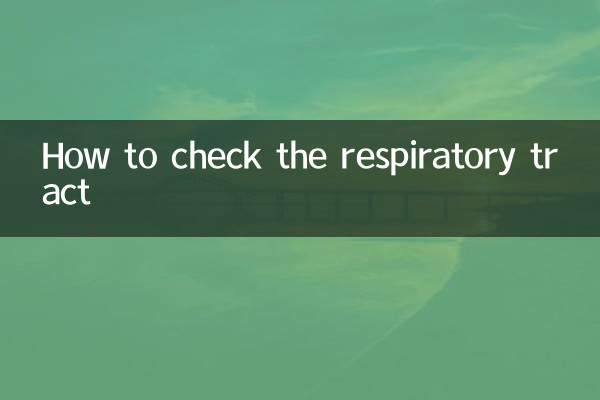How to check the respiratory tract
Respiratory examination is an important part of medical diagnosis, especially in the recent season of high incidence of respiratory diseases. Understanding examination methods is crucial for prevention and treatment. The following is detailed content about respiratory examination, combined with recent hot topics and structured data to help you gain a comprehensive understanding of this topic.
1. Common methods of respiratory examination

Respiratory examination mainly includes physical examination, imaging examination, laboratory examination and functional examination. The following are specific categories:
| Check type | Specific methods | Applicable scenarios |
|---|---|---|
| Physical examination | Auscultation, percussion, palpation | Preliminarily determine whether there are abnormalities in the respiratory tract |
| Imaging examination | X-ray, CT, MRI | Diagnose lung infections, tumors, etc. |
| laboratory tests | Blood routine and sputum examination | Detect pathogens or indicators of inflammation |
| Function check | Pulmonary function tests, bronchoscopy | Assess lung ventilation function or directly observe the airway |
2. Recent popular respiratory diseases and related examinations
In the past 10 days, the respiratory diseases that have been hotly discussed on the Internet mainly include influenza, mycoplasma pneumonia and new coronavirus variant infection. The following is a comparison of related inspection methods:
| Disease name | High-risk groups | Recommended inspection methods |
|---|---|---|
| influenza | children, elderly | Throat swab test, blood routine |
| Mycoplasma pneumonia | teenager | Serum antibody test, chest X-ray |
| New coronavirus mutant strain | whole crowd | Nucleic acid testing, antigen testing |
3. Precautions for respiratory examination
1.Preparation before inspection: Some examinations require fasting or fasting, such as fasting for 6 hours before bronchoscopy.
2.Cooperate during inspection: Follow the doctor’s instructions, keep your breathing steady and avoid severe coughing.
3.Post-examination care: If invasive examination (such as bronchoscopy) is performed, it is necessary to observe whether there is bleeding or difficulty breathing.
4. How to choose the respiratory examination that suits you
Choose the appropriate test method based on your symptoms and doctor’s recommendations:
| symptom | possible disease | Recommended to check |
|---|---|---|
| Cough, fever | influenza, pneumonia | Blood routine, chest X-ray |
| difficulty breathing | Asthma, COPD | Pulmonary function test |
| Long-term cough with bloody sputum | Tuberculosis, lung cancer | CT, bronchoscopy |
5. Preventive measures for respiratory diseases
1.Get vaccinated: Flu vaccine, pneumonia vaccine, etc. can effectively reduce the risk of infection.
2.Wear a mask: Wear a mask when there are crowded crowds or when the air pollution is serious.
3.Enhance immunity: Eat a balanced diet, exercise moderately, and avoid staying up late.
4.Regular physical examination: Especially people with chronic respiratory diseases should undergo regular pulmonary function tests.
Summarize
Respiratory examination is a critical step in diagnosing and treating respiratory disease. Through the structured data in this article, you can clearly understand the applicable scenarios and precautions for different inspection methods. There has been a high incidence of influenza, mycoplasma pneumonia and other diseases recently. It is recommended to seek medical treatment promptly when symptoms appear, choose appropriate examination methods, and do daily preventive work.

check the details

check the details